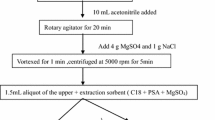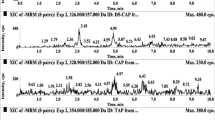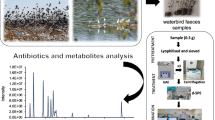Abstract
A simple, sensitive and rapid liquid chromatography–tandem mass spectrometry method (LC–MS/MS) was developed and validated to monitor the presence of gabapentin as environmental contaminant in albumen and yolk of eggs from grazing flocks exposed to open air stored saline wastes from pharmaceutical industry. The method involved a simple liquid extraction followed by a gradient elution with formic acid 0.2 % and acetonitrile in reverse phase. ESI ionization was performed in positive ion mode. The tandem mass spectrometer was operated in multiple reaction monitoring mode. The calibration curves were linear in the concentration range from 5 to 400 ng/g for the two matrices with correlation coefficients that exceeded 0.990. The limits of quantitation were 12.0 and 14.8 ng/g in albumen and yolk, respectively. Results are discussed in light of the pharmacokinetics of gabapentin in experimentally exposed hens, accounting for the top soil intake in such free grazing animals.

Similar content being viewed by others
References
Annesley T (2003) Ion suppression in mass spectrometry. Clin Chem 49:1041–1044
Barbosa J, Freitas A, Mourao JL, Silveira MIN, Ramos F (2012) Determination of Furaltadone and Nifursol residues in poultry eggs by liquid chromatography–electrospray ionization tandem mass spectrometry. J Agric Food Chem 60:4227–4234
Borrey DC, Godderis KO, Engelrelst VI, Bernard DR, Langlois MR (2005) Quantitative determination of vigabatrin and gabapentin in human serum by gas chromatography–mass spectrometry. Clin Chim Acta 354:147–151
Chang SY, Wang FY (2004) Determination of gabapentin in human plasma by capillary electrophoresis with laser-induced fluorescence detection and acetonitrile stacking technique. J Chromatogr B 799:265–270
Colombo A, Benfenati E, Bugatti SG, Celeste G, Lodi M, Fanelli R (2011) Concentrations of PCDD/PCDF in soil close to a secondary aluminum smelter. Chemosphere 85:1719–1724
Commission Decision 2002/657/EC of 12 August 2002 implementing Council Directive 96/23/EC concerning the performance of analytical methods and the interpretation of results. Off J Eur Communities L 221:8–36
EFSA Contaminants Panel (2008) Cross-contamination of non-target feedingstuffs by nicarbazin authorised for use as a feed additive. EFSA J 690:1–34
EFSA Contaminants Panel (2013) Guidance on methodological principles and scientific methods to be taken into account when establishing Reference Points of Action (RPAs) for non-allowed pharmacologically active substances present in food of animal origin. EFSA J 11:3195–3218
Gambelunghe C, Mariucci G, Tantucci M, Ambrosini MV (2005) Gaschromatography-tandem mass spectrometry analysis of gabapentin in serum. Biomed Chromatogr 19:63–67
Gil A (2005) Management of the salt cake from secondary aluminum fusion processes. Indian Eng Chem Res 44:8852–8857
Gunal AI, Ozalp G, Yoldas TK, Gunal SY, Kirciman E, Celiker H (2004) Gabapentin therapy for pruritus in haemodialysis patients: a randomized, placebo-controlled, double-blind trial. Nephrol Dial Transplant 19:3137–3139
Liu Y, Uboh CE, Soma LR, Li X, Guan F, You Y, Rudy JA, Chen JW (2011) Analysis of gabapentin in equine plasma with measurement uncertainty estimation by liquid chromatography–tandem mass spectrometry. J Anal Toxicol 35:75–84
Maurer HH (2007) Current role of liquid chromatography–mass spectrometry in clinical and forensic toxicology. Anal Bioanal Chem 388:1315–1325
Taverniers I, de Loose M, Van Bockstaele E (2004) Analytical method validation and quality assurance. Trends Anal Chem 23:533–551
Vermeij TA, Edelbroek PM (2004) Simultaneous high-performance liquid chromatographic analysis of pregabalin, gabapentin and vigabatrin in serum by precolumn derivatization with o-phtaldialdehyde and fluorescence detection. J Chromatogr B 810:297–303
VKM-Norwegian Scientific Committee for Food Safety (2009) Opinion from the panel on contaminants in the risk assessment of contaminants in sewage sludge applied on Norwegian soils. www.vkm.no
Waegeneers N, De Steur H, De Temmerman L, Van Steenwinkel S, Gellynck X, Viaene J (2009) Transfer of soil contaminants to home-produced eggs and preventive measures to reduce contamination. Sci Total Environ 407:4438–4446
Wolf CE, Saady JJ, Poklis A (1996) Determination of gabapentin in serum using solid-phase extraction and gas-liquid chromatography. J Anal Toxicol 20:498–501
Zhu Z, Neirinck L (2002) High-performance liquid chromatographic method for the determination of gabapentin in human plasma. J Chromatogr B 779:307–312
Acknowledgments
Grant from National Ministry of Health 2009 – ENVIFOOD project – is acknowledged.
Conflict of interest
The authors declare they have no conflicts of interest.
Author information
Authors and Affiliations
Corresponding author
Rights and permissions
About this article
Cite this article
Nieddu, M., Baralla, E., Burrai, L. et al. Investigation on Gabapentin Residues in Eggs from Free-Range Hens Exposed to Saline Slags from Pharmaceutical Industry. Bull Environ Contam Toxicol 92, 662–666 (2014). https://doi.org/10.1007/s00128-014-1250-5
Received:
Accepted:
Published:
Issue Date:
DOI: https://doi.org/10.1007/s00128-014-1250-5




